人教版八年级下册英语教案unit1教学内容
- 格式:docx
- 大小:11.42 KB
- 文档页数:4
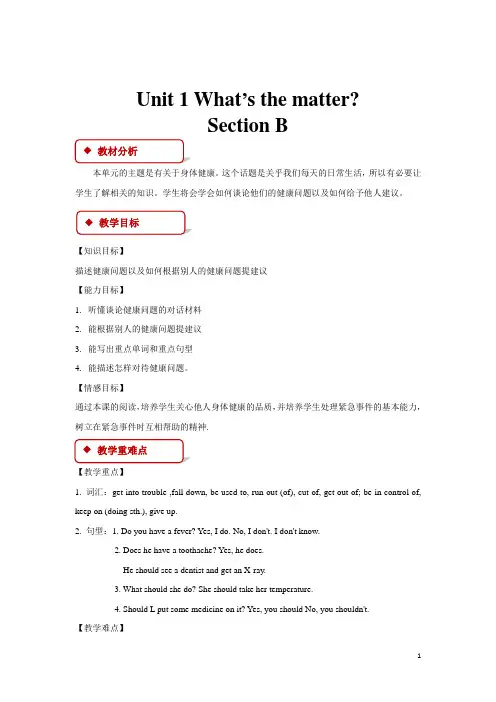
Unit 1 What’s the matter?Section B本单元的主题是有关于身体健康。
这个话题是关乎我们每天的日常生活,所以有必要让学生了解相关的知识。
学生将会学会如何谈论他们的健康问题以及如何给予他人建议。
【知识目标】描述健康问题以及如何根据别人的健康问题提建议【能力目标】1.听懂谈论健康问题的对话材料2.能根据别人的健康问题提建议3.能写出重点单词和重点句型4.能描述怎样对待健康问题。
【情感目标】通过本课的阅读,培养学生关心他人身体健康的品质,并培养学生处理紧急事件的基本能力,树立在紧急事件时互相帮助的精神.【教学重点】1. 词汇:get into trouble ,fall down, be used to, run out (of), cut of, get out of; be in control of, keep on (doing sth.), give up.2. 句型:1. Do you have a fever? Yes, I do. No, I don't. I don't know.2. Does he have a toothache? Yes, he does.He should see a dentist and get an X-ray.3. What should she do? She should take her temperature.4. Should L put some medicine on it? Yes, you should No, you shouldn't.【教学难点】掌握情态动词should shouldn't.的用法;学习have的用法Multimedia,group work, cooperative discussionStep 1 Warm upReview the knowledge we have learned in Section AStep 2 Presentation1. 1aWhen these accidents happen, what should you do? Put the actions in order.Give Ss some time to finish this pat, then check the answers.2. 1bListen to the school nurse. Check the problems.Finally, check the answers.3. 1cAsk Ss to listen to the conversation again and write the letter of each treatment next to the problems in the chart above. Then, check the answers.Step 3 Consolidation1. 2aAccidents or problems can sometimes happen when we do sports. Write the letter of each sport next to each accident or problem that can happen.2. 2bFirst, lead Ss to read the instruction to know what to do in this activity and how to do it.Then, give Ss several minutes to read the passage and look up the new words in a dictionary. Ask them to underline some difficult language points as reading.After they finish reading, invite three Ss to read the passage.Lead Ss to read the passage together, call attention to the pronunciation and tone. Explain some key words and expressions.3. 2cRead the statements and circle True, False or Don't Know. Then,check the answers.Step 4 Practice1. 2dFirst, read the passage again and answer the questions.Then, invite several Ss to present their answers.Finally, check the answers.2.2ePut the sentences in the correct order. Then use them to tell Aron's story to your partner. Try to add other details from the reading.3.3bWrite a conversation between the nurse and the student using the notes in 3a.Give Ss enough time to do the task. Then invite some Ss to present their conversations to the class.4. Self checkStep 5 HomeworkMake a conversation about health problems and giving advice.略。
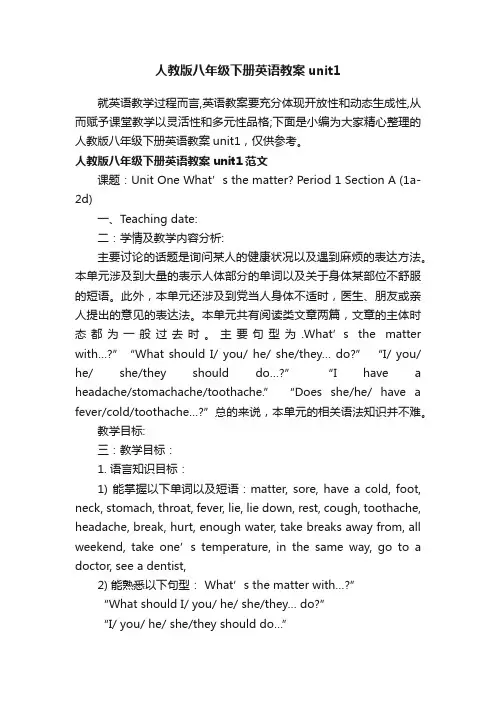
人教版八年级下册英语教案unit1就英语教学过程而言,英语教案要充分体现开放性和动态生成性,从而赋予课堂教学以灵活性和多元性品格;下面是小编为大家精心整理的人教版八年级下册英语教案unit1,仅供参考。
人教版八年级下册英语教案unit1范文课题:Unit One What’s the matter? Period 1 Section A (1a-2d)一、Teaching date:二:学情及教学内容分析:主要讨论的话题是询问某人的健康状况以及遇到麻烦的表达方法。
本单元涉及到大量的表示人体部分的单词以及关于身体某部位不舒服的短语。
此外,本单元还涉及到党当人身体不适时,医生、朋友或亲人提出的意见的表达法。
本单元共有阅读类文章两篇,文章的主体时态都为一般过去时。
主要句型为.What’s the matter with…?”“What should I/ you/ he/ she/they… do?” “I/ you/ he/ she/they should do…?” “I have a headache/stomachache/toothache.” “Does she/he/ have a fever/cold/toothache…?”总的来说,本单元的相关语法知识并不难。
教学目标:三:教学目标:1. 语言知识目标:1) 能掌握以下单词以及短语:matter, sore, have a cold, foot, neck, stomach, throat, fever, lie, lie down, rest, cough, toothache, headache, break, hurt, enough water, take breaks away from, all weekend, take one’s temperature, in the same way, go to a doctor, see a dentist,2) 能熟悉以下句型:What’s the matter with…?”“What should I/ you/ he/ she/they… do?”“I/ you/ he/ she/they should do…”2. 情感态度价值观目标:教会学生关心他人,培养同学间团结、友善的精神。
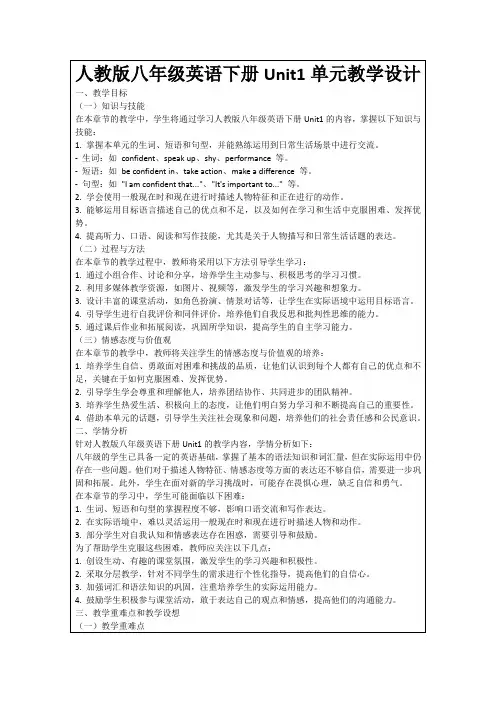
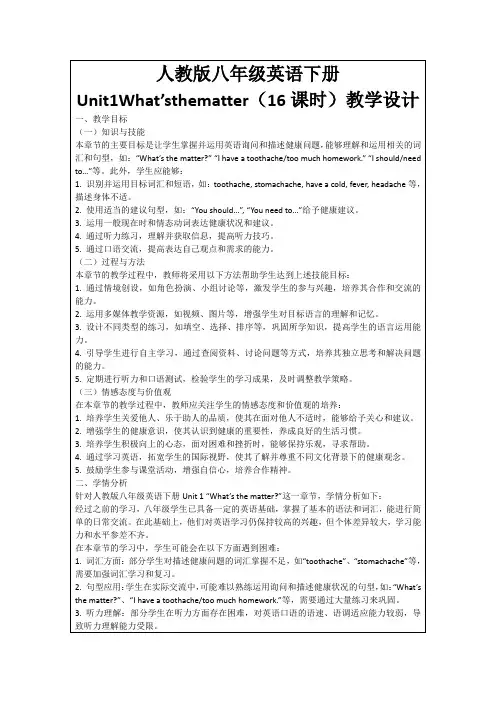
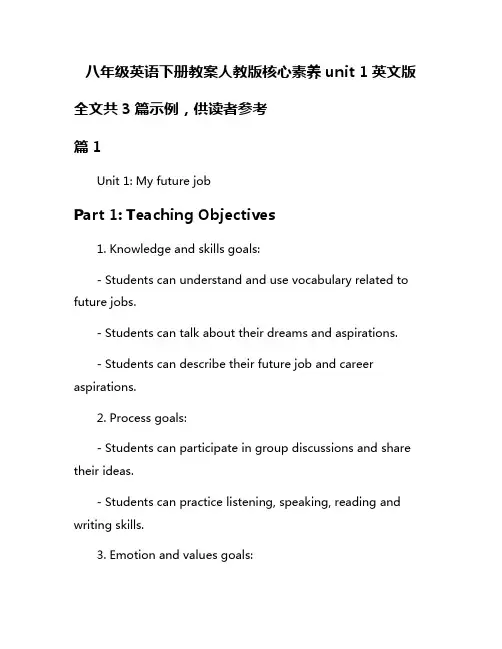
八年级英语下册教案人教版核心素养unit 1英文版全文共3篇示例,供读者参考篇1Unit 1: My future jobPart 1: Teaching Objectives1. Knowledge and skills goals:- Students can understand and use vocabulary related to future jobs.- Students can talk about their dreams and aspirations.- Students can describe their future job and career aspirations.2. Process goals:- Students can participate in group discussions and share their ideas.- Students can practice listening, speaking, reading and writing skills.3. Emotion and values goals:- Students can develop a positive attitude towards planning for their future.- Students can appreciate the importance of setting goals and working towards achieving them.Part 2: Teaching Content1. Vocabulary: job titles (teacher, doctor, engineer, etc.), job responsibilities (teaching, healing, designing, etc.), job requirements (skills, education, experience, etc.).2. Grammar: Future tense (will/won't + base form of the verb).3. Speaking and Listening: discussing future goals and aspirations, describing future job aspirations.4. Reading and Writing: reading and writing about future job aspirations.Part 3: Teaching Procedures1. Warm-up: (10 minutes)- Show pictures of different job titles and ask students to guess the job titles.- Play a guessing game where students describe a job without using the job title and others have to guess the job.- Discuss the importance of setting goals and working towards achieving them.2. Presentation: (20 minutes)- Introduce vocabulary related to future jobs using flashcards or pictures.- Present and practice the future tense with examples.- Show a video or audio clip of people talking about their future career aspirations.3. Practice: (30 minutes)- Divide students into pairs or small groups to discuss their dreams and future job aspirations.- Have students write a short paragraph describing their future job aspirations.- Conduct a role play activity where students act out a job interview scenario.4. Production: (20 minutes)- Ask students to present their future job descriptions to the class.- Have students write a short essay about their dream job, including job title, responsibilities, requirements, and reasons for choosing that job.5. Review: (10 minutes)- Review vocabulary and grammar covered in the lesson.- Summarize key points and discuss the importance of setting goals for the future.Part 4: Assessment- Assessment can be done through written assignments, oral presentations, and class participation.- Encourage students to reflect on their learning and set goals for improving their English skills in the future.篇2Unit 1: Our worldLesson 1: We need to protect our worldObjectives:1. Students will be able to understand the importance of protecting our environment.2. Students will be able to discuss different ways to protect our world.3. Students will be able to use target vocabulary related to the environment.Warm-up: To start the lesson, the teacher can show pictures of environmental issues such as pollution, deforestation, and climate change. Students can discuss in pairs or small groups what they see in the pictures and why it is important to protect our world.Presentation: The teacher can introduce key vocabulary words related to the environment such as pollution, recycling, conservation, and sustainable. Students can repeat after the teacher to practice pronunciation.Practice: Students can work in pairs to discuss different ways to protect our environment. They can also brainstorm ideas on how they can make a difference in their daily lives to help the environment.Production: In groups, students can create a poster or a presentation about a specific environmental issue and how theycan make a positive impact in solving it. They can present their work to the class and engage in a discussion about each group's topic.Homework: Students can write a short paragraph about what they can do to protect our world. They can also research and find information about a specific environmental issue and write a summary of their findings.Assessment: The teacher can assess students based on their participation in class discussions, their creativity and teamwork during the group project, and the quality of their homework assignment.Overall, this lesson aims to raise awareness about the importance of protecting our environment and empower students to take action to make a difference in the world. By fostering a sense of responsibility and empathy towards the planet, students will be better equipped to contribute to a more sustainable and eco-friendly future.篇3Unit 1 Get ready for the futureTeaching Goals:1. Enable students to understand and use the target language in real-life situations2. Develop students' listening, speaking, reading, and writing skills3. Encourage students to think about their future plans and goalsTeaching Procedures:Part 1: Warm-up (10 minutes)- Start the lesson by asking students about their future plans and goals. This can be done in a whole-class discussion or in small groups.- Have students share their aspirations, such as what they want to be when they grow up or where they want to visit in the future.- Encourage students to think about why these goals are important to them and how they plan to achieve them.Part 2: Listening and Speaking (20 minutes)- Play a video or audio clip of people talking about their future plans and goals. Ask students to listen carefully and take notes.- After playing the clip, have students work in pairs or small groups to discuss what they heard and share their notes.- Encourage students to ask each other questions about their future plans and offer advice or support.Part 3: Reading (20 minutes)- Distribute a reading passage about different career options and their requirements. Have students read the passage silently and underline any unfamiliar vocabulary.- Divide students into pairs and have them discuss the different career options mentioned in the passage. Ask them to talk about the skills and qualifications needed for each career.- The teacher can then lead a whole-class discussion on the importance of education and training in achieving future goals.Part 4: Writing (20 minutes)- Ask students to write a short paragraph about their future plans and goals. They can include information about their desired career, education, hobbies, and aspirations.- Encourage students to use the target language learned in class and to be as descriptive as possible.- Once students have finished writing, have them share their paragraphs with a partner or with the whole class.Part 5: Assessment and Extension (10 minutes)- To assess students' understanding of the lesson material, give them a short quiz on the target language and key concepts covered in class.- For extension activities, ask students to research a specific career or field of interest and present their findings to the class.- Provide feedback on students' work and encourage them to continue thinking about their future plans and how they can achieve success.Homework:Assign students to write a reflection on their future goals and the steps they will take to achieve them. Encourage them to be specific and realistic in their planning.Overall, this lesson aims to inspire students to think about their future with optimism and determination. By developing their language skills and critical thinking abilities, students will bebetter prepared to face the challenges and opportunities that lie ahead.。
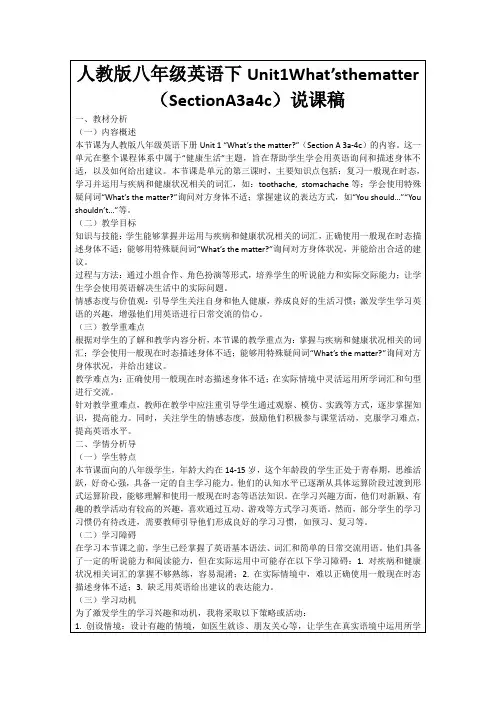
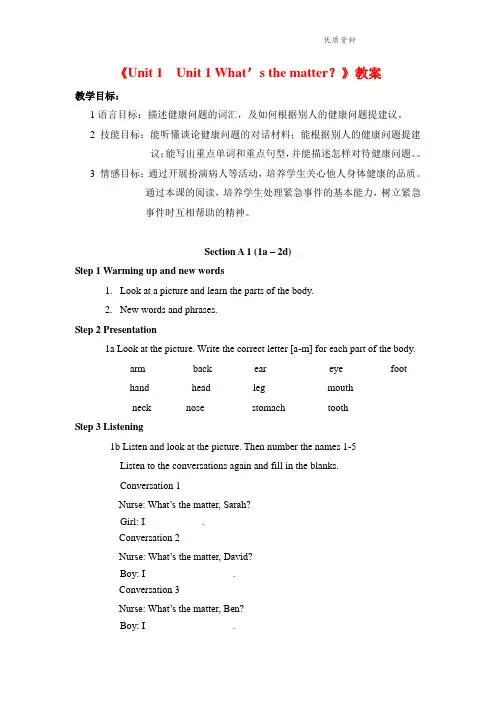
《Unit 1 Unit 1 What’s the matter?》教案教学目标:1语言目标:描述健康问题的词汇,及如何根据别人的健康问题提建议。
2 技能目标:能听懂谈论健康问题的对话材料;能根据别人的健康问题提建议;能写出重点单词和重点句型,并能描述怎样对待健康问题。
3 情感目标:通过开展扮演病人等活动,培养学生关心他人身体健康的品质。
通过本课的阅读,培养学生处理紧急事件的基本能力,树立紧急事件时互相帮助的精神。
Section A 1 (1a – 2d)Step 1 Warming up and new words1.Look at a picture and learn the parts of the body.2.New words and phrases.Step 2 Presentation1a Look at the picture. Write the correct letter [a-m] for each part of the body.___arm ___ back ___ ear ___ eye ___ foot___hand ___ head ___ leg ___ mouth___ neck ___nose ___ stomach ___ toothStep 3 Listening1b Listen and look at the picture. Then number the names 1-5Listen to the conversations again and fill in the blanks.Conversation 1Nurse: What’s the matter, Sarah?Girl: I ___________.Conversation 2Nurse: What’s the matter, David?Boy: I _________________.Conversation 3Nurse: What’s the matter, Ben?Boy: I _________________.Conversation 4Nurse: What’s the matter, Nancy?Girl: I _________________.Conversation 5Betty: What’s the matter, Judy?Ann: She __________________.Step 4 Speaking1c Look at the pictures. What are the students’ problems? Make conversati ons.ExamplesA: What’s the matter with Judy?B: She talked too much yesterday and didn’t drink enough water.She has a very sore throat now.A: What’s the matter with Sarah?B: She didn’t take care of herself on the weekend. She was p laying withher friends at the park yesterday. Then it got windy, but she didn’t puton her jacket. Now she has a cold.Step 5 Guessing gamesGuess what has happened to the students by using the important sentenc es. Step 6 Listening2a Listen and number the pictures [1-5] in the order you hear them.2b Listen again. Match the problems with the advice.Step 7 Speaking2c Make conversations using the information in 2a and 2bA: What’s the matter?B: My head feels very hot.A: Maybe you have a fever.B: What should I do?A: You should take your temperature.Step 8 Role–playImagine you are the school doctor. A few students have health problems.Role-play a conversation between the doctor and the students.2d Role –play the conversationStep 9 Language points and summary1. What’s the matter?这是人们特别是医生和护士询问病人病情时最常用的问句, 意思是“怎么了?”其后通常与介词with连用。
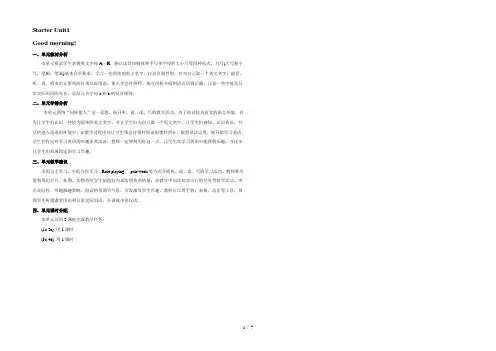
Starter Unit1Good morning!一、单元教材分析本单元要求学生掌握英文字母A—H,能认读其印刷体和手写体字母的大小写等四种形式。
书写(大写和小写,笔顺,笔画)基本合乎要求。
学习一些简单的英文名字,注意区别性别,并为自己取一个英文名字。
能看、听、说、唱本单元所列的日常交际用语,重点学会打招呼、相互问候并做到语音语调正确。
注意一些字母及日常交际用语的发音,总结元音字母a和e的发音规则。
二、单元学情分析本单元围绕“问候他人”这一话题,展开听、说、读、写的教学活动。
为了创设较为真实的语言环境,首先让学生们认识一些较为简单的英文名字,并让学生们为自己取一个英文名字,让学生们感知、认识英语,并尽快进入英语的环境中。
在教学过程中应让学生体会打招呼用语的奥妙所在,做到灵活运用。
刚开始学习英语,学生们肯定对学习英语的兴趣非常深厚,教师一定要利用好这一点,让学生在学习英语中能获得乐趣。
并逐步让学生们形成稳定的学习兴趣。
三、单元教学建议采用自主学习、小组合作学习、Role playing、pair work等方式开展听、说、读、写的学习活动。
教师要尽量利用幻灯片、挂图、实物等给学生创造较为真实的英语情景。
在教学中创设切实可行的任务型教学活动、突出交际性。
引趣激趣策略,创设情景调节气氛,引发激发学生兴趣。
教师可以用手势,表情,动作等示意,帮助学生听懂课堂用语和日常交际用语,不讲或少讲汉语。
四、单元课时分配本单元可用2课时完成教学任务:(1a-2e) 用1课时(3a-4d) 用1课时(1a-2d)一、教学目标:1. 语言知识目标:1) 能掌握以下词汇:字母Aa ~ Hh, good, morning, Good morning!, hi, hello2) 能掌握以下句型:①Good morning, Helen!②Hello, Frank!③Hi, Bob!3) 能理解用英语打招呼的不同说法,并能灵活运用。
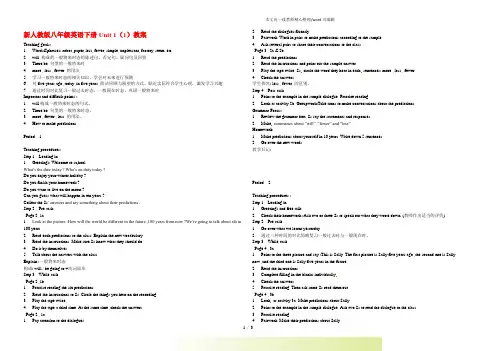
新人教版八年级英语下册Unit 1(1)教案Teaching goals:1. Words&phrases: robot, paper, less, fewer, simple, unpleasant, factory, seem, etc .2. will 构成的一般将来时态的陈述句、否定句、疑问句及回答.3. There be 句型的一般将来时.4. more , less , fewer 的用法.5. 学习一般将来时态的相关知识,学会对未来进行预测.6. 对five years ago ,today ,in five years 简洁回顾与展望的方式,贴近实际符合学生心理,激发学习兴趣.7. 通过时间对比复习一般过去时态、一般现在时态,巩固一般将来时.Important and difficult points :1. will构成一般将来时态的句式。
2. There be 句型的一般将来时态。
3. more , fewer , less 的用法。
4. How to make predictions .Period 1Teaching procedures:Step 1 Leading in1. Greetings: Welcome to sc hool .What’s the date today ? Who’s on duty today ?Do you enjoy your winter holiday ?Do you finish your homework ?Do you want to live on the moon ?Can you guess what will happen in ten years ?Collect the Ss’ answers and say something about their predictions .Step 2 Pre-taskPage 2 ,1a .1. Look at the picture :How will the world be different in the future ,100 years from now ?We’re going to talk about sth in 100 years .2. Read each predictions to the class .Explain the new vocabulary .3. Read the instructions .Make sure Ss know what they should do .4. Do it by themselves .5. Talk about the answers with the class .Explain :一般将来时态构成: will / be going to +动词原形Step 3 While-taskPage 2 ,1b .1. Practise reading the six predictions .2. Read the instructions to Ss .Circle the things you hear on the recording .3. Play the tape twice .4. Play the tape a third time .At the same time ,check the answers .Page 2 , 1c .1. Pay attention to the dialogues .2. Read the dialogues fluently .3. Pairwork .Work in pairs to make predictions according to the sample .4. Ask several pairs to share their conversations to the class .Page 3 , 2a & 2b .1. Read the predictions .2. Read the instructions and point out the sample answer .3. Play the tape twice .Ss circle the word they hear in each sentences: more , less , fewer .4. Check the answers .学生探究: less , fewer 的区别。
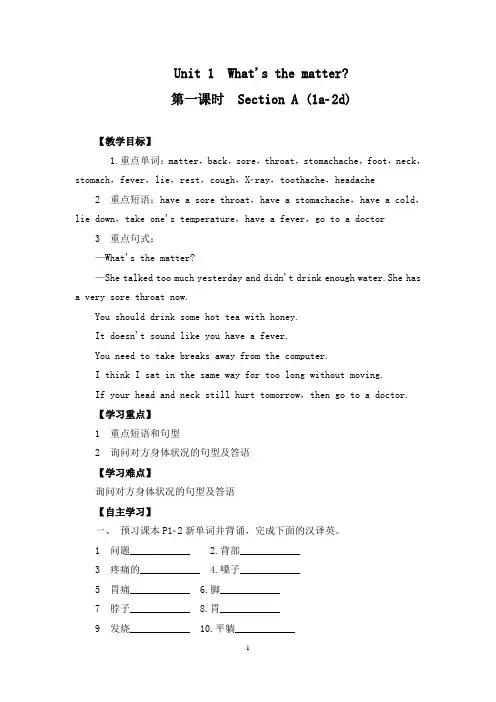
Unit 1 What's the matter?第一课时Section A (1a2d)【教学目标】1.重点单词:matter,back,sore,throat,stomachache,foot,neck,stomach,fever,lie,rest,cough,Xray,toothache,headache2 重点短语:have a sore throat,have a stomachache,have a cold,lie down,take one's temperature,have a fever,go to a doctor3 重点句式:—What's the matter?—She talked too much yesterday and didn't drink enough water.She has a very sore throat now.You should drink some hot tea with honey.It doesn't sound like you have a fever.You need to take breaks away from the computer.I think I sat in the same way for too long without moving.If your head and neck still hurt tomorrow,then go to a doctor.【学习重点】1 重点短语和句型2 询问对方身体状况的句型及答语【学习难点】询问对方身体状况的句型及答语【自主学习】一、预习课本P12新单词并背诵,完成下面的汉译英。
1 问题____________ 2.背部____________3 疼痛的____________ 4.嗓子____________5 胃痛____________ 6.脚____________7 脖子____________ 8.胃____________9 发烧____________ 10.平躺____________11 休息____________ 12.咳嗽____________13 X光____________ 14.牙疼____________15 头疼____________二、认真预习1a2d找出下列短语和句型。
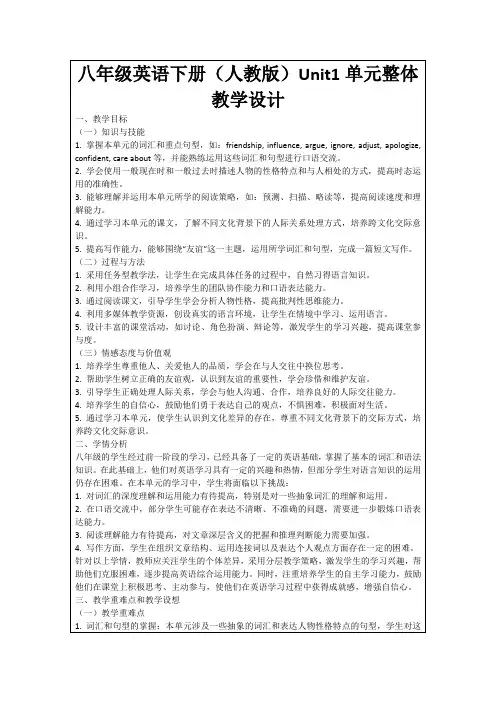
新人教版八年级下册初中英语全册教案(教学设计)一. 教学目标本教案旨在帮助八年级学生掌握下册初中英语的相关知识和技能,包括听、说、读、写四个方面的能力提高。
二. 教学内容本教案涵盖了全册的教学内容,包括以下单元和主要教学点:1. Unit 1: Meeting New Friends- 语言点:be动词的一般现在时- 活动:介绍新朋友- 阅读:了解文化差异2. Unit 2: The First Day at School- 语言点:一般过去时- 活动:描述第一天上学的经历- 阅读:理解校园规则3. Unit 3: I Love Reading- 语言点:情态动词can和must - 活动:介绍喜欢的书籍- 阅读:阅读理解4. Unit 4: My School Life- 语言点:形容词比较级和最高级- 活动:描述学校生活的不同方面- 阅读:了解不同的学校生活5. Unit 5: Our Future Jobs- 语言点:职业相关词汇- 活动:谈论未来的职业- 阅读:了解不同的职业6. Unit 6: Weather and Climate- 语言点:天气相关词汇和短语- 活动:讨论天气和气候- 阅读:了解不同地区的气候7. Unit 7: Enjoy Your Trip- 语言点:旅行相关词汇和短语- 活动:计划和描述旅行- 阅读:阅读旅行指南8. Unit 8: At the Farm- 语言点:动词的现在进行时- 活动:描述在农场的经历- 阅读:了解农场生活三. 教学方法本教案使用多种教学方法,包括但不限于:听力练、口语对话、阅读理解、小组讨论、写作练等。
教师将根据具体情况选择合适的教学方法进行教学。
四. 教学步骤1. 引入新课,激发学生兴趣。
2. 执行听力练以提高学生听力能力。
3. 进行口语对话练,帮助学生提高口语表达能力。
4. 进行阅读理解练,加深学生对课文的理解。
5. 进行小组讨论,让学生互相交流观点。
Unit1 Section B 2a-2d Reading He lost his arm but is still climbing一、教学内容八年级下unit1 What’s the matter section B 中的阅读课文,课文讲述的是一个真实的故事,美国的Aron Rostlon 在登山的过程中陷入险境,自断手臂求生的故事。
二、学情分析本节课的单词在前几课已经学习过,因为文章讲述的是真实的故事,比较容易吸引学生的兴趣,能够更好的完成阅读任务。
三、教学目标1.知识与技能(1)掌握重点的词汇和单词,理解复杂句式的含义。
(2)能够在老师的引导下用mind map来叙述Aron的故事。
(3)能使用不同的阅读策略来完成阅读任务,更好的理解文章内容。
2.过程与方法(1)导入:使用多媒体播放视频,导入故事的情节,并设置悬念以吸引同学们的注意力。
(2)读前:设计Free talk 和文章标题及图片对课文的内容进行预测。
(3)速读:让同学们进行快速阅读,掌握文章大意,并完成相应阅读。
(4)细读:逐段进行仔细阅读,在阅读策略的引导下完成不同的阅读任务。
(5)读后:引导学生用树状图,流程图和括号图来复述课文,并进行课后拓展。
3.情感态度与价值观(1)引导学生理解:在生活或学习中,遇到困难或危险的时候要做出明智的选择。
(2)通过Aron的故事来告诉学生,追逐梦想,坚持梦想,永不言弃。
四、教学重难点1.教学重点(1)words: ourselves, situation, decision, control, spirit, deathphrases: take risks, ran out, kept on, be in control of.sentences: As a mountain climber, Aron is used to taking risks.Aron tells of the importance of making good decisions, and of being in control of one’s life.(2)更好地理解文章,并能够用事情发展的顺序来叙述故事。
人教版八年级下册英语教案u n i t1
人教版八年级下册英语教案unit1
课题:Unit One What’s the matter? Period 1 Section A (1a-2d)
一、Teaching date:
二:学情及教学内容分析:
主要讨论的话题是询问某人的健康状况以及遇到麻烦的表达方法。
本单元涉及到大量的表示人体部分的单词以及关于身体某部位不舒服的短语。
此外,本单元还涉及到党当人身体不适时,医生、朋友或亲人提出的意见的表达法。
本单元共有阅读类文章两篇,文章的主体时态都为一般过去时。
主要句型为.What’s the matter with…?”“What should I/ you/ he/ she/they… do?”“I/ you/ he/ she/they should do…?”“I have a headache/stomachache/toothache.”“Does she/he/ have a fever/cold/toothache…?”总的来说,本单元的相关语法知识并不难。
教学目标:
三:教学目标:
1. 语言知识目标:
1) 能掌握以下单词以及短语:matter, sore, have a cold, foot, neck, stomach, throat, fever, lie, lie down, rest, cough, toothache, headache, break, hurt, enough water, take breaks away from, all weekend, take one’s temperature, in the same way, go to
a doctor, see a dentist,
2) 能熟悉以下句型: What’s the matter with…?”
“What should I/ you/ he/ she/they… do?”
“I/ you/ he/ she/they should do…”
2. 情感态度价值观目标:
教会学生关心他人,培养同学间团结、友善的精神。
四:教学重难点
掌握相关的单词和词组,并能够灵活运用会使用以下句型:“What’s the matter with…?”“What should I/ you/ he/ she/they… do?”“I/ you/ he/ she/they should do…”
五:教学流程:
Step1 Greet the whole class as usual.
T: What’s the date today?/ What day is it today?/ How’s the weather?/ How was your weekend?/What do you usually do on weekends?/ Do you like exercising?/ How often do you exercise?/ That’s great! To do exercise can keep us healthy, but if we don’t pay attention to our health, there will be something wrong with our body. Now , look at these people.
Learn some new words.
Step2 引入一般过去时,对上学期所学知识进行复习。
Step3 Learn 1a on page 1. Look at the picture. Write the correct letter.
arm, back, ear, eye, foot…
Step4 1b Listen and look at the picture, then number the names on page 1.
Nancy Sarah David…
Step5 Practice the conversations.
What’s the matter with…? She talked too much yesterday.
知识点归纳:
当某人心情沮丧,闷闷不乐,身体不舒服或是遇到麻烦事时,可以用下列问句:
What’s the matter? What’s wrong with sb/sth?
某人/某物怎么了?(sb:哪儿不舒服/出什么事了/为何不高兴?sth:某物出了毛病或故障)可以用下列问句:What’s the matter with you?/ What’s the trouble with you?/ What’s your trouble?/ What’s wrong with you? /Is there anything wrong with you?
Step 6 Listen and number the pictures on page 2.
Step 7 Listen again and then match.
1. fever a. lie down and rest
2. stomachache b.drink some hot tea with honey
3.cough and sore throat c. see a dentist
……
知识点归纳:
You should drink some hot tea with honey.
(1) with 做介词,意为“有,带有”表示某物带有或具有某种特征。
介词短语with honey做hot tea 的后置定语。
例:a tall girl with long curly hair.
(2)with还有“和某人某物在一起”,表示伴随。
例:I like to talk with my friends.
with还有“用……”表示使用“某种工具、手段等”
例:Cut it with a knife/wirte with a pen/with the help of……或with one’s help
with还有“关于……对于……”表示“关系和适应范围”例:be angry with
Step 8 Role-play the conversation.
先带领学生学习书中对话部分所出现的语法知识,新的词组以及新的句型。
并要求学生熟读本部分课文。
对话中主要词组:take breaks away from, all weekend, take one’s temperature, in the same way, go to a doctor, see a dentist, get an X-ray, cut oneself.。